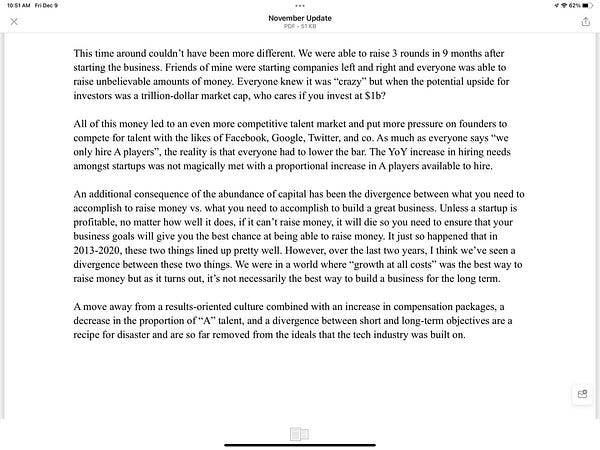In a moderately down week for the markets, the WCLD cloud index fell 3% to $25.25. Inflation data continues to run hot while fears of recession next year are widespread.
In the world of startups, the news that most caught my eye was the continuing trend of celebrated Unicorns and Decacorns announcing major layoffs.
This past week, both Plaid and Airtable announced ~20% reductions of their workforce. Both of these companies have high-margin, software-based business with significant revenue scale.
I don’t have insider info, but I’d be surprised if both don’t have 100m+ in ARR and gross margins of 70%. It’s a serious indictment of the exuberance of the past few years that companies with such highly innovative products, loyal customers bases, and sound unit economics got so far ahead of their skis. But it’s a sign of the times.
In a year that’s already seen widespread job cuts and a troubled economy, why would companies like Plaid & Airtable wait until this past week to do layoffs?
The Elon Effect.
Elon Musk has shown that Twitter can survive with a massively reduced (70% less, it seems) headcount. CEO’s, founders, and boards across tech are asking themselves: “could we also operate with a significant reductions?”





“Growth at all costs” is long gone. Profits are fashionable. We should expect the layoffs to continue.
In another turnaround - fortunately, a much more positive one - SF seems to be coming back.

The tech layoff cycle will continue to be painful, but a somewhat-functioning SF could provide some much-needed support. While I expect the broader tech economy to have plenty of challenges over the next 2-4 quarters, an AI boom is imminent and I’d expect SF to be at the epicenter.
Podcast Recommendation of the Week:
I can’t find the podcast version of it, but this video interview with Anshu Sharma is worth checking out for Sharma’s incisive & somewhat contrarian perspectives on build an enterprise software startup in today’s challenging market. As much as I’m an aficionado of bottom-up & PLG, there are great software businesses to be built in the enterprise and it requires a much different mindset around product & GTM. Sharma is also an entertaining & knowledgeable Twitter follow (for ex, he’s been one of the biggest public crypto skeptics for many years).
Reading Recommendation of the Week:
The PLG model is so compelling because it can lead to scalable, highly efficient growth for software businesses. The great ones - such as Atlassian, Zoom, Shopify, Canva - were all able to achieve massive growth with very little, if any, outside capital. It’s possible to do that with a sales-led model, but I like your chances more if you’re PLG.
However, Tom Tunguz, author of the one of the best VC blogs, shows that scaled PLG companies have become efficiency laggards. Looking at public SaaS companies in 2022, the sales-led are operating with significantly greater efficiency than the product-led. I would argue that this trend is more a function of an environment was aggressively over-funding PLG and encouraging reckless spending, not a function of the PLG model itself. Yet the data is clear and worth a look. (T’unguz’ blog post with rich data here)




